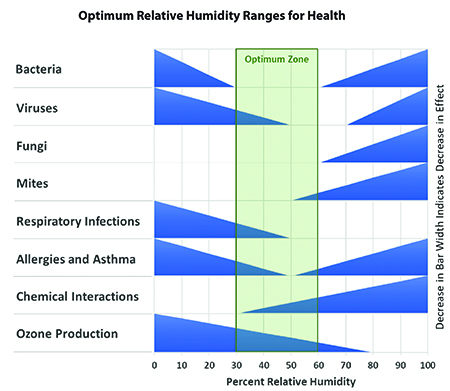In this article, we look at the importance of humidity for indoor comfort, air quality, and health. The authors, Dennis and Ben, hail from two drastically different locations in the U.S. Dennis lives in Florida, where it can be hot and very humid for much of the year. Ben is from northwestern Montana where the climate is cold and dry in the winter.

Here is a combination of their perspectives regarding challenges with humidity and the indoor environment in these wildly different climates. Here is also what you can do to help your customers overcome these challenges.
Let’s look at the impacts of high humidity during the cooling season and low humidity during the heating season. Plus we’ll examine how to manage humidity for the best comfort, health, and efficiency outcomes.
Humidity Impacts Air Quality, Health, and Building Integrity
In the humid Southeast, where Dennis lives, the biggest issues related to humidity occur during the cooling season when it’s humid outside. If not controlled, indoor humidity levels can reach 80%, or even higher! Most experts agree that indoor humidity should be kept below 60%, and, ideally, below 50% (ncilink.com/RH60).

Studies show that when relative humidity (RH) is above 50%, dust mite populations increase. This causes allergies to flare up in many people. Humidity at these levels can also trigger episodes of asthma. Above 60%, bacteria and mold grow more quickly. Both bacteria and mold can lead to increased illness. Mold also can lead to unsightly stains or even structural damage in a home.
In the Northern United States, Ben can attest firsthand that cold wintertime temperatures cause problems with low humidity.
Cold air holds less moisture, and after heating it, relative humidity can get extremely low. He’s observed humidity as low as 15% inside his house! The same experts who recommend upper limits for indoor humidity put the lower limit at 30%.
Below 30% RH, bacteria, viruses, respiratory infections, allergies, and asthma increase. Dry air allows airborne germs to float (or fly) further and live longer, increasing the chance of transmitting that illness from one person to another.
One study finds that raising average humidity from 23% to 35% in 12 Canadian schools over 11 years reduces absences due to illness by 20% (ncilink.com/RaiseRH). Who knew that dry air is a serious issue beyond causing those annoying little shocks from static electricity?
Click Below for the Next Page:













Recent Comments